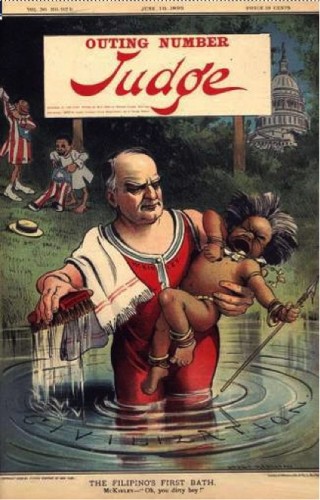Philippines After the Spanish-American War
Time: 1 Block period (1:45)
Common Core Standards: RH1, RH5, WHST2
Objectives:
- The students will place events in the correct sequential order along a timeline
- The students will explain why certain events led to greater or less freedom for the Philippines
- The students will be able to understand how the Philippines achieved independence
- The students will comprehend why America was hesitant to grant the Philippines full independence
Initiation:

Project the cover of Judge Magazine. If the students are unable to read the text, tell them the date at the top is June 1899. The caption reads “The Filipino’s First Bath: McKinley --‘Oh you dirty boy!’”
Ask the students to describe what they see – who is the man in the bathing suit? Who is he bathing? What does the water say? What does this represent? Who are the 2 people in background? What is the artist’s purpose in drawing this? Etc. Make sure to explain the racial and gender inferences included in the cartoon since racialization, genderization, and infantilization were key factors in how the United States handled the Filipinos. (10 minutes)
Learning Activities:
- Before class begins, place each of the 7 events around the classroom by cutting them and taping them to the walls.
- Following the warm-up questions, distribute a timeline to students. Tell them that they will be looking at 7 major events over a 50-year period that led to independence for the Philippines. Some events led to greater independence, while other events took freedom away from the region. They will analyze each event to determine how it affected the Philippines and place it correctly along the timeline. (5 minutes for directions)
- Tell the students to start at the event on the wall closest to their desk. After reading about the event, they need to determine if it brought greater or lesser freedom for the Philippines. If the event brought greater foreign control, they should place it on the bottom half of the page. If the event was getting the Philippines closer to becoming independent, it should go above the timeline. Students should write the name of the Act/Commission/Event and then briefly explain what it did.
- Allow the students about 5 minutes at their station and then have them rotate to the next one as a group. Adjust the time if the students need more or less time at each until they have rotated completely around the room and gotten each event on their timelines. (45 minutes)
- Once the students have completed their timelines have them return to their seats and hand out the worksheet. Have the students create a political cartoon to represent one of the events for their timeline. After the students have completed their cartoons, ask some students to sharer and explain their drawing’s viewpoint. Be sure to let the students understand that each event is evaluated in different ways today and many historians disagree about whether some led to greater independence or were just lip service. You can also show them some of the cartoons from the PBS – Crucible of Empire website listed in the “Other Primary Sources” section. (20 minutes)
Closure:
After students have shared some of their cartoons, as a concluding activity have them answer the remaining questions on the worksheet. (15 minutes)
Other Primary Sources:
The Spanish American War in Motion Pictures (Library of Congress)
Puerto Rico at the Dawn of the Modern Age (Library of Congress)
Crucible of Empire (PBS) – Yellow Journalism Cartoon Gallery
The Birth of the American Empire as Seen Through Political Cartoons
http://www.jstor.org/stable/25163220
Cartoons of the Spanish American War
Further Reading:
In Our Image: America's Empire in the Philippines by Stanley Karnow
MOROLAND: The History of Uncle Sam and the Moros 1899-1920 by Robert A. Fulton
Journey of 100 Years: Reflections on the Centennial of Philippine Independence by Cecilia Brainard and Edmundo Litton
The Forbidden Book: The Philippine-American War in Political Cartoons by Abe Ignacio, Enrique de la Cruz, Jorge Emmanuel, & Helen Toribio
A War of Frontier and Empire: The Philippine-American War, 1899-1902 by David Silbey
Benevolent Assimilation: The American Conquest of the Philippines, 1899-1903 by Stuart Creighton Miller
Policing America's Empire: The United States, the Philippines, and the Rise of the Surveillance State by Alfred W. McCoy
The Blood of Government: Race, Empire, the United States, and the Philippines by Paul Kramer
America at War: The Philippines, 1898-1913 by A.B. Feuer
The Philippine War by Brian McAllister Linn
Soldiers in the Sun: An Adventure in Imperialism by William Thaddeus Sexton
|


